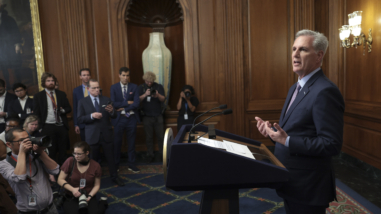Flip charts and post-its will only take you so far. (Photo Credit: Samuel Mann, licensed under CC BY 2.0)
Like laws and sausages, organizational strategies are best appreciated once they have been made. Busy nonprofit executive directors, in particular, often experience strategic planning as a frustrating time sink of cat-herding, budget-massaging, and word-smithing. Still, nonprofits do better when they have a sound strategy in place, and defining one entails a thoughtful exercise in leadership. I won’t presume to cover what distinguishes a good strategy from a bad one in this post (though here is a great primer from Richard Rumelt). However, in the fifteen years I spent as a consultant to nonprofit, government, and business leaders, I repeatedly witnessed a core set of leadership practices increasing the likelihood of developing and executing a good strategy. I found myself sharing these observations in an email last week with the leaders of a fledging enterprise that is just embarking on a strategic planning process, so I thought I would share them more broadly for other nonprofit leaders setting off on a similar journey.
1. First and foremost, make sure this is a top priority for you (or wait until it becomes one): The single biggest determinant of success in these efforts is the personal investment of the leader of the organization in the process. Other factors can vary, but if the planning effort is important to the person in charge, it tends to work out; if it’s not, it doesn’t. The litmus test of “important” here, in my book, is that you see developing a strategy as one of your top three priorities. If you find yourself mulling over issues and questions related to the emerging strategy in the shower or on your commute, that’s a good sign. If not, far better to wait to do your planning until you have the time, energy, and interest to do so rather than to try to force things when you don’t.
2. If you are using an outside advisor, choose one you can trust—then trust them: While not essential, in many circumstances the right outside consultant can provide the perspective, process, and push you need. But choose carefully. Develop a shortlist of potential candidates. Check the references they provide (and some they don’t). Meet in person with two or three finalists to get a feel for how they think and what it would be like to work with them. Then, once you have selected an advisor, rely on them. The more you can think out loud with them on matters of substance, and the more feedback you give them on what is working well (or not), the better the counsel you will get in return.
3. Use the planning work to rally your team and board: A mistake leaders often make is trying to plan on their own, without engaging colleagues and trustees, either because they don’t want to take up their time or because they don’t want to give up any control over the plan itself. This will keep you from forming what change management guru John Kotter refers to as the “guiding coalition,” which provides both the diversity of perspectives you need to develop a great strategy and the allies and champions that you will ultimately rely on to carry it out. Give meaty planning roles to key team members—as project managers or working team leaders, for example—and watch them grow. Ensure that a small group of influential and supportive board members participate in a steering committee that guides the effort, and engage the full board at a few different points over the course of the effort. It will help them—and you—develop.
4. Consider (and reconcile) both ends and means: Some planning efforts spend a lot of time on big picture questions of vision and strategy but never get down to brass tacks: who is going to do what, how much it will cost, and who will pay for it? Other efforts go straightaway to these prosaic matters without paying any attention to the big picture. The truth is you need to work on both fronts, and—this is key—ensure that your strategy and programming, on one hand, and your organization and finances, on the other, hang together and reinforce each other.
5. Bring fresh information and perspectives to bear (but be wary of diminishing returns): Planning is an opportunity to gather and reflect on new data and feedback to fully inform your thinking. It can’t simply be a facilitated discussion. If you aren’t surprised by new information at some point in the process, you haven’t dug deep enough. But you also need to avoid “analysis paralysis.” Clarify the key open questions to focus the data gathering and analysis. Generate and test hypotheses, then decide. You won’t analyze your way to the right answer, only to a set of better-informed judgment calls that you’ll still need to make.
6. Take as much time as it takes (but no longer): Given planning is an extra effort, and that you need clarity on your strategy as soon as possible, you will want to move quickly. Remember though you want to bring a critical mass of influential stakeholders along so that they understand the plan and will be standing in your corner when it comes time to execute it. You shouldn’t presume that they are tracking its development at the same level and pace you are. Take time to get their input and enlist their support. You want to go slow to go fast here. But not too slow, as people (not least you!) can lose interest in a process that lacks decisive momentum.
7. It’s ultimately about the process, not the product: As should be clear from the practices above, the real benefit of planning is not the final document but rather the discipline the process imposes, the new information it generates, the working relationships it fosters, and the conversations, insights, and commitments it sparks. To paraphrase and mash-up von Moltke the Elder and Eisenhower, no plan survives contact with the real world, but the process of planning is indispensable. You are the leader of the organization. Don’t regard a sustained investment of your time to get a good strategy up and running as a distraction from your work. It is your work!
Are there any other effective practices that you’ve used or observed? Please weigh in using the comment box below.




